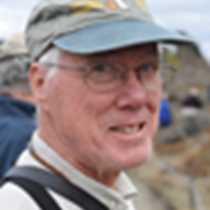Aaltanhash Inlet, British Columbia
Sometime early in 2001 a female brown bear (also known as grizzly) gave birth to three small, nearly naked cubs in a den in the coastal mountains of northern British Columbia. For the rest of the winter she nursed them in the den, converting her own body resources into rich milk. In spring mother and cubs left the den to roam through the mountains and along the coastline, mother always seeking the food resources required by her growing cubs. She dug the roots of western skunk cabbage from the forest. She foraged on small fish and crabs in pools left by falling tide along the shoreline, and scraped mussels and barnacles from the intertidal rocks. Later in the season she harvested the bounty of salmon bringing resources from the ocean into the rivers of British Columbia as they returned to spawn. In fall she took the three cubs higher into the mountains to harvest berries, converting the sugar into the fat that they would all need to survive the coming winter. She was a successful mother. All three cubs reached their first birthday in their winter den, and emerged, hungry, earlier this spring.
For a brief moment today our paths converged. We spent our morning cruising up a narrow, glacially carved passage between Princess Royal Island and mainland British Columbia. Temperate Rain Forest dominated by magnificent Sitka spruce, Western hemlock, and red- and Alaska-cedar covered the steep slopes, with smaller shore pine eking out an existence in hanging bogs. Waterfalls and cascades brought meltwater from the winter snowfall down the steep valley slopes. Shortly after lunch sharp eyes on the bridge spotted our mother grizzly and her three cubs. The shallow draft of the Sea Bird allowed our ship to come close and we gathered on the foredeck, whispering so as not to frighten the bears, as the cubs turned over rocks in the intertidal zone and mother lay her head on a fallen log for a well-earned rest. The ideal nature observation is one in which we observe, learn from the experience, and then depart leaving the object of our encounter undisturbed, and so we did today.
Once brown or grizzly bear occurred over much of North America, but they have not fared well in competition with man. They remain as a symbol of the wildness of the remote regions of the Pacific Northwest.
Sometime early in 2001 a female brown bear (also known as grizzly) gave birth to three small, nearly naked cubs in a den in the coastal mountains of northern British Columbia. For the rest of the winter she nursed them in the den, converting her own body resources into rich milk. In spring mother and cubs left the den to roam through the mountains and along the coastline, mother always seeking the food resources required by her growing cubs. She dug the roots of western skunk cabbage from the forest. She foraged on small fish and crabs in pools left by falling tide along the shoreline, and scraped mussels and barnacles from the intertidal rocks. Later in the season she harvested the bounty of salmon bringing resources from the ocean into the rivers of British Columbia as they returned to spawn. In fall she took the three cubs higher into the mountains to harvest berries, converting the sugar into the fat that they would all need to survive the coming winter. She was a successful mother. All three cubs reached their first birthday in their winter den, and emerged, hungry, earlier this spring.
For a brief moment today our paths converged. We spent our morning cruising up a narrow, glacially carved passage between Princess Royal Island and mainland British Columbia. Temperate Rain Forest dominated by magnificent Sitka spruce, Western hemlock, and red- and Alaska-cedar covered the steep slopes, with smaller shore pine eking out an existence in hanging bogs. Waterfalls and cascades brought meltwater from the winter snowfall down the steep valley slopes. Shortly after lunch sharp eyes on the bridge spotted our mother grizzly and her three cubs. The shallow draft of the Sea Bird allowed our ship to come close and we gathered on the foredeck, whispering so as not to frighten the bears, as the cubs turned over rocks in the intertidal zone and mother lay her head on a fallen log for a well-earned rest. The ideal nature observation is one in which we observe, learn from the experience, and then depart leaving the object of our encounter undisturbed, and so we did today.
Once brown or grizzly bear occurred over much of North America, but they have not fared well in competition with man. They remain as a symbol of the wildness of the remote regions of the Pacific Northwest.




